Heating Performance Characteristics of High-Voltage PTC Heater for an Electric Vehicle
Abstract
:1. Introduction
2. Experiment Equipment and Methods
2.1. Heater Design Improvement
2.2. Experimental Equipment Setup
2.3. Experiment Conditions and Methods
3. Heating Performance Results
3.1. Performance Results According to Operating Conditions
3.1.1. Effect of the Airflow Rate
3.1.2. Effect of the Air Inlet Temperature
3.1.3. Effect of the Input Voltage
3.2. Analysis of Shape Parameters
3.2.1. Physical Model
3.2.2. Mathematical Background
3.2.3. Boundary Condition
3.2.4. Analysis Results and Discussion
3.3. Evaluation of Improved Model
4. Conclusions
Acknowledgments
Author Contributions
Conflicts of Interest
Abbreviation
| Nomenclatures | |
| Specific heat (J/kg·K) | |
| F | Fin |
| Current (A) | |
| Mass flow rate (kg/s) | |
| Temperature (°C) | |
| Input voltage (V) | |
| PTC heater weight (kg) | |
| Energy efficiency (%) | |
| Density (kW/kg) | |
| Subscripts | |
| a | Air |
| gp | Gravimetric power |
| i | Inlet |
| o | Outlet |
| p | Pitch |
| t | Thickness |
References
- Li, S.; Wang, S.; Ma, Z.; Jiang, S.; Zhang, T. Using an Air Cycle Heat Pump System with a Turbocharger to Supply Heating for Full Electric Vehicles. Int. J. Refrig. 2017, 77, 11–19. [Google Scholar] [CrossRef]
- Kwon, C.K.; Kim, M.S.; Choi, Y.G.; Kim, M.S. Performance Evaluation of a Vapor Injection Heat Pump System of Electric Vehicles. Int. J. Refrig. 2017, 74, 138–150. [Google Scholar] [CrossRef]
- Kambly, K.R.; Bradley, T.H. Estimating the HVAC Energy Consumption of Plug-in Electric Vehicles. J. Power Sources 2014, 259, 117–124. [Google Scholar] [CrossRef]
- Zahraei, M.S.; Kouzami, A.Z.; Kutter, S.; Baker, B. Intergrated Thermal and Energy Management of Plug-in Hybrid Electric Vehicles. J. Power Sources 2012, 216, 237–248. [Google Scholar] [CrossRef]
- Zhang, G.; Zou, H.; Qin, F.; Xue, Q.; Tian, C. Investigation on an Improved Heat Pump AC System with the View of Return Air Utilization and Anti-fogging for Electric Vehicles. Appl. Therm. Eng. 2017, 115, 726–735. [Google Scholar] [CrossRef]
- Zhang, G.; Qin, F.; Zou, H.; Tian, C. Experimental Study on a Dual-parallel-evaporator Heat Pump System for Thermal Management of Electric Vehicles. Energy Procedia 2017, 105, 2390–2395. [Google Scholar] [CrossRef]
- Zhang, X.; Xue, Q.; Zou, H.; Liu, J.; Tian, C.; Zhang, X. Influence of Heat Exchanger Tube Layout on Performance of Heat Pump System for Electric Cars. Energy Procedia 2017, 105, 5085–5090. [Google Scholar] [CrossRef]
- Cho, C.P.; Kim, G.C.; Pyo, Y.D.; Lee, W.H. The development of an energy-efficient heating system for electric vehicles. In Proceedings of the IEEE Transportation Electrification Conference and Expo, Asia-Pacific (ITEC), Busan, Korea, 1–4 June 2016; pp. 883–885. [Google Scholar]
- Kim, K.Y.; Kim, S.C.; Kim, M.S. Experimental Studies on the Heating Performance of the PTC Heater and Heat Pump Combined System in Fuel Cells and Electric Vehicles. Int. J. Automot. Technol. 2012, 13, 971–977. [Google Scholar] [CrossRef]
- Musat, R.; Helerea, E. Characteristics of the PTC Heater Used in Automotive HVAC Systems. IFIP Adv. Inf. Commun. Technol. 2010, 314, 461–468. [Google Scholar]
- Shin, Y.H.; Lim, D.H.; Kim, D.G.; Ahn, S.K.; Kim, K.Y.; Kim, S.C. Development of a PTC Elements and a Heater as Supplementary Heating for Internal Combustion Engine. In Proceedings of the Fall Conference KSME 2013, Jeongseon, Korea, 18–20 December 2013; pp. 3400–3403. [Google Scholar]
- Gu, J.S.; Oh, K.H.; Jeong, S.H.; Wang, Y.H. A Study on Applying Hybrid PTC Heater to vehicle for Heating Performance Improvement. In Proceedings of the Spring Conference KSAE 2016, Jeju, Korea, 19–21 May 2016; pp. 762–767. [Google Scholar]
- Lim, D.H.; Shin, Y.H.; Sim, S.K.; Song, J.W.; Ahn, S.K.; Kim, S.C. The Flow Analysis and Heating Performance Evaluation of PTC Heater for Electric Vehicles. In Proceedings of the Fall Conference KSAE 2016, Jeju, Korea, 19–21 May 2016; pp. 1234–1236. [Google Scholar]
- Shin, Y.H.; Ahn, S.K.; Kim, S.C. Performance Characteristics of PTC Elements for an Electric Vehicle Heating System. Energies 2016, 9, 813. [Google Scholar] [CrossRef]
- Shin, Y.H.; Sim, S.K.; Kim, S.C. Performance Characteristics of a Modularized and Integrated PTC Heating System for an Electric Vehicle. Energies 2016, 9, 18. [Google Scholar] [CrossRef]
- American Society of Heating; Refrigerating and Air-Conditioning Engineers, Inc. 2009 ASHRAE Handbook—Fundamentals (SI Edition); ASHRAE: Atlanta, GA, USA, 2009; Chapter 13–15. [Google Scholar]
- Picard, A.; Davis, R.S.; Glaser, M.; Fujii, K. Revised Formula for the Density of Moist Air (CIPM-2007). Metrologia 2008, 45, 149–155. [Google Scholar] [CrossRef]
- Marra, F.; Yang, G.Y.; Træholt, C.; Larsen, E.; Rasmussen, C.N.; You, S. Demand Profile Study of Battery Electric Vehicle under Different Charging Options. In Proceedings of the 2012 IEEE Power & Energy Society General Meeting, San Diego, CA, USA, 22–26 July 2012. [Google Scholar] [CrossRef]
- Paladini, V.; Donateo, T.; Risi, A.D.; Laforgia, D. Super-capacitors Fuel-cell Hybrid Electric Vehicle Optimization and Control Strategy Development. Energy Convers. Manag. 2007, 48, 3001–3008. [Google Scholar] [CrossRef]
- FLUENT Inc. Fluent 6.3 User’s Guide; Centerra Resource Park 10 Cavendish Court Lebanon: Hanover, NH, USA, 2006. [Google Scholar]
- Welty, R.J.; Wicks, C.E.; Wilson, R.E. Fundamentals of Momentum, Heat and Mass Transfer, 3rd ed.; John Wiley and Sons: New York, NY, USA, 1984. [Google Scholar]
- Versteeg, H.K.; Malalasekera, W. An Introduction to Computational Fluid Dynamics: Finite Volume Method; Longman Scientific and Technical: Essex, UK, 1995. [Google Scholar]
- Boris, D.; Anica, T.; Kristain, L. Numerical Investigation of Heat Transfer Enhancement in a Fin and Tube Heat Exchanger Using Vortex Generators. Int. J. Heat Mass Transf. 2014, 78, 662–669. [Google Scholar]
- Kim, Y.C.; Sung, N.S.; Jin, K.S.; Cho, H.T. Consideration of High Voltage PTC Heater. In Proceedings of the Spring Conference KSAE 2016, Jeju, Korea, 19–21 May 2016; pp. 560–564. [Google Scholar]

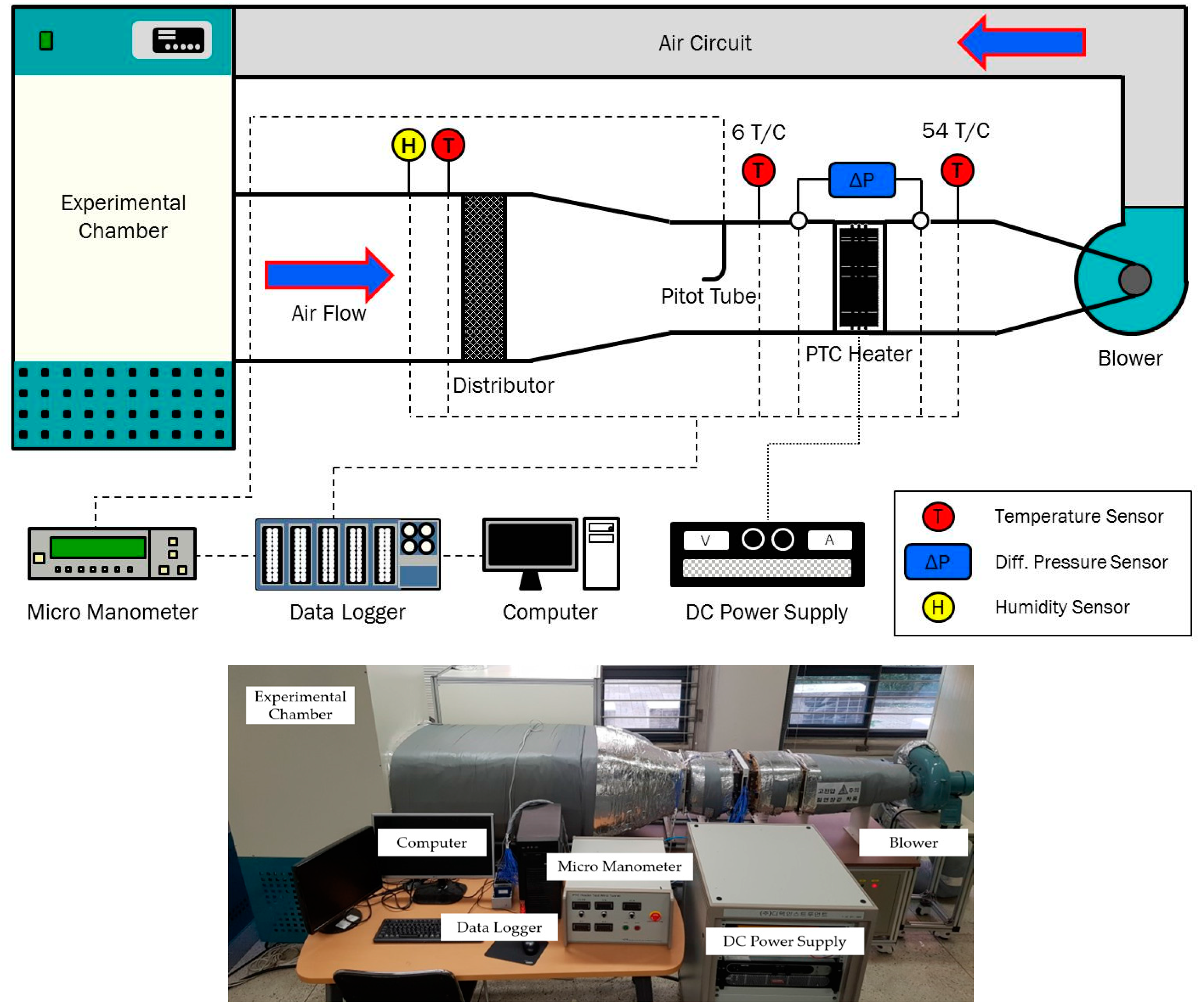
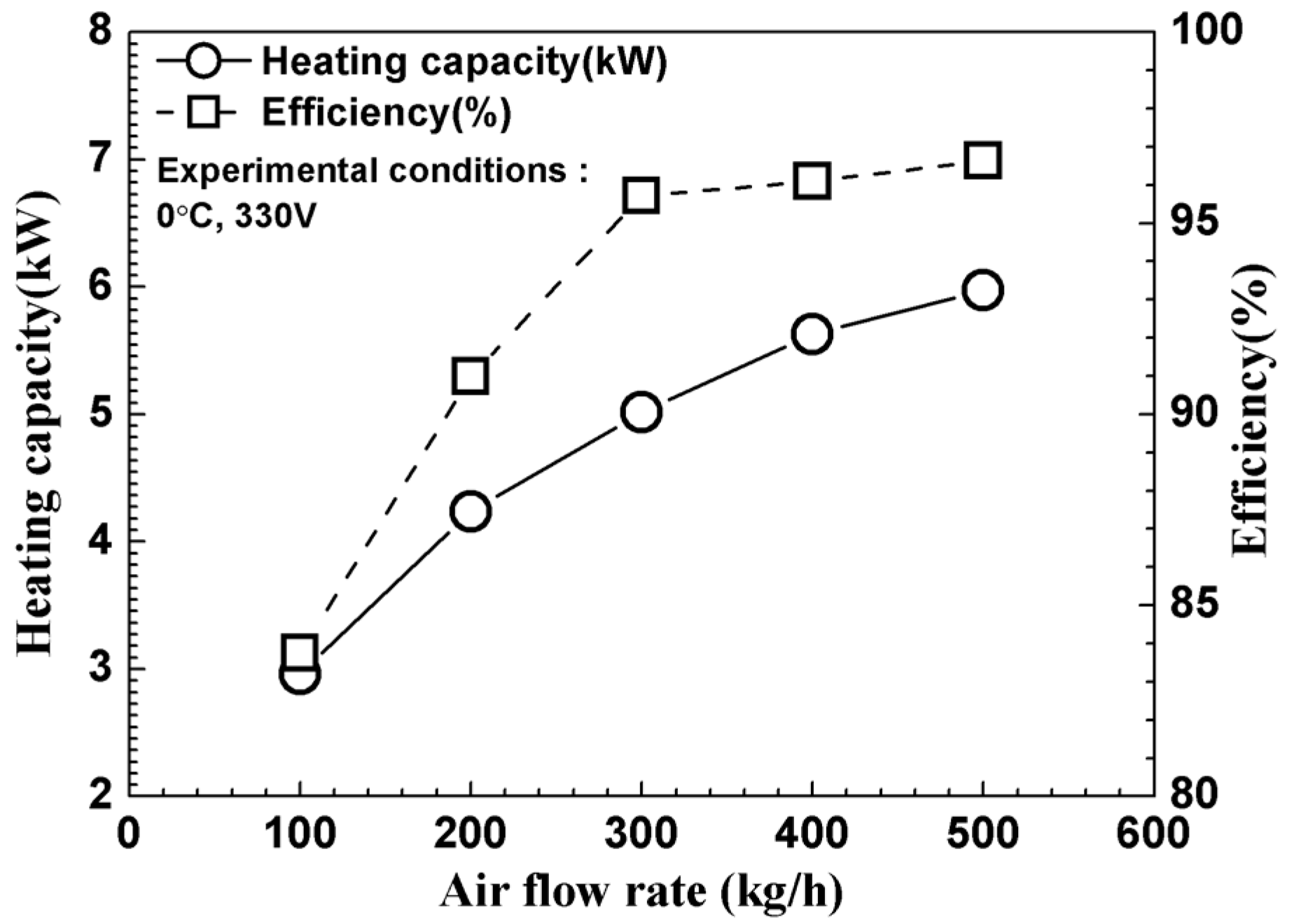
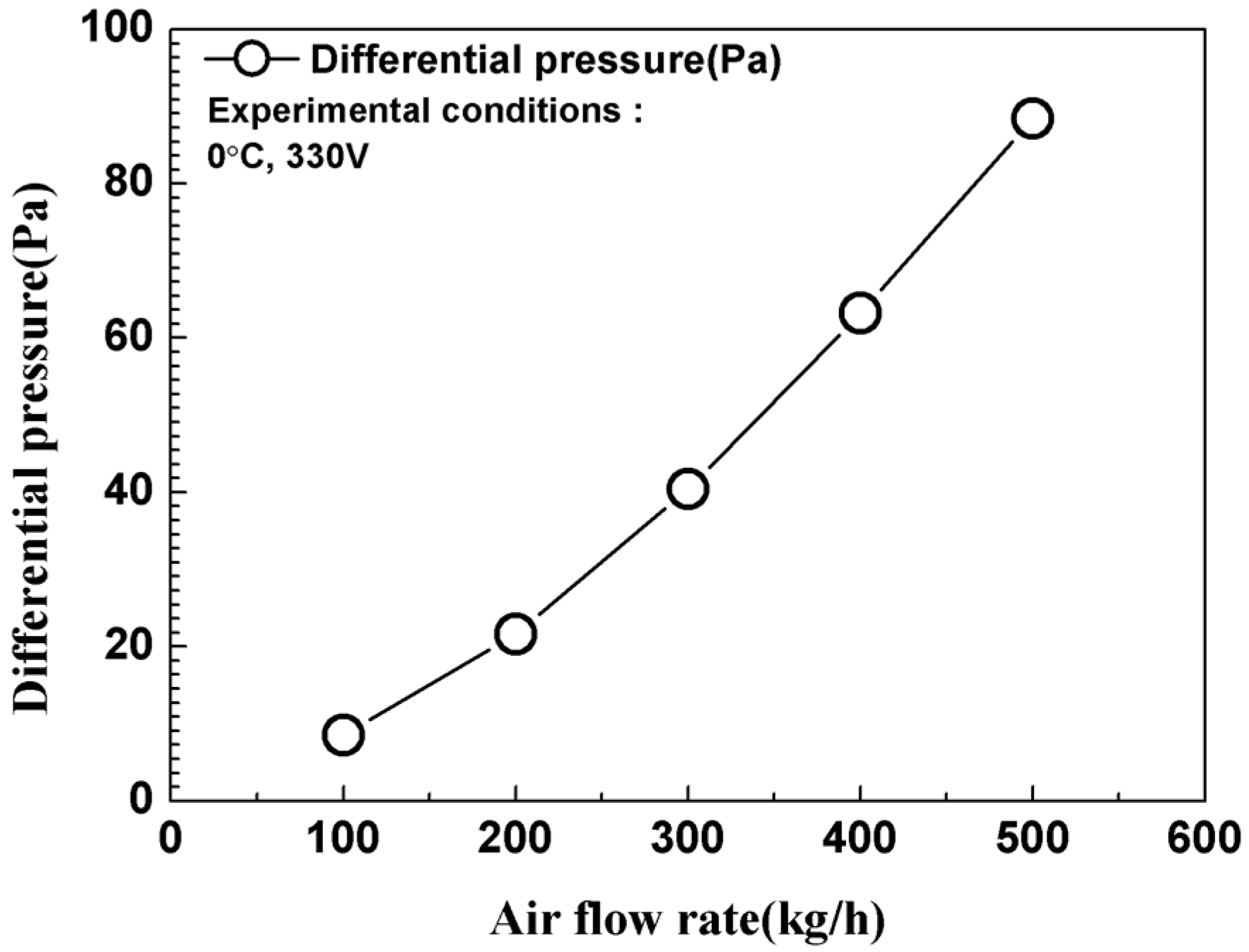
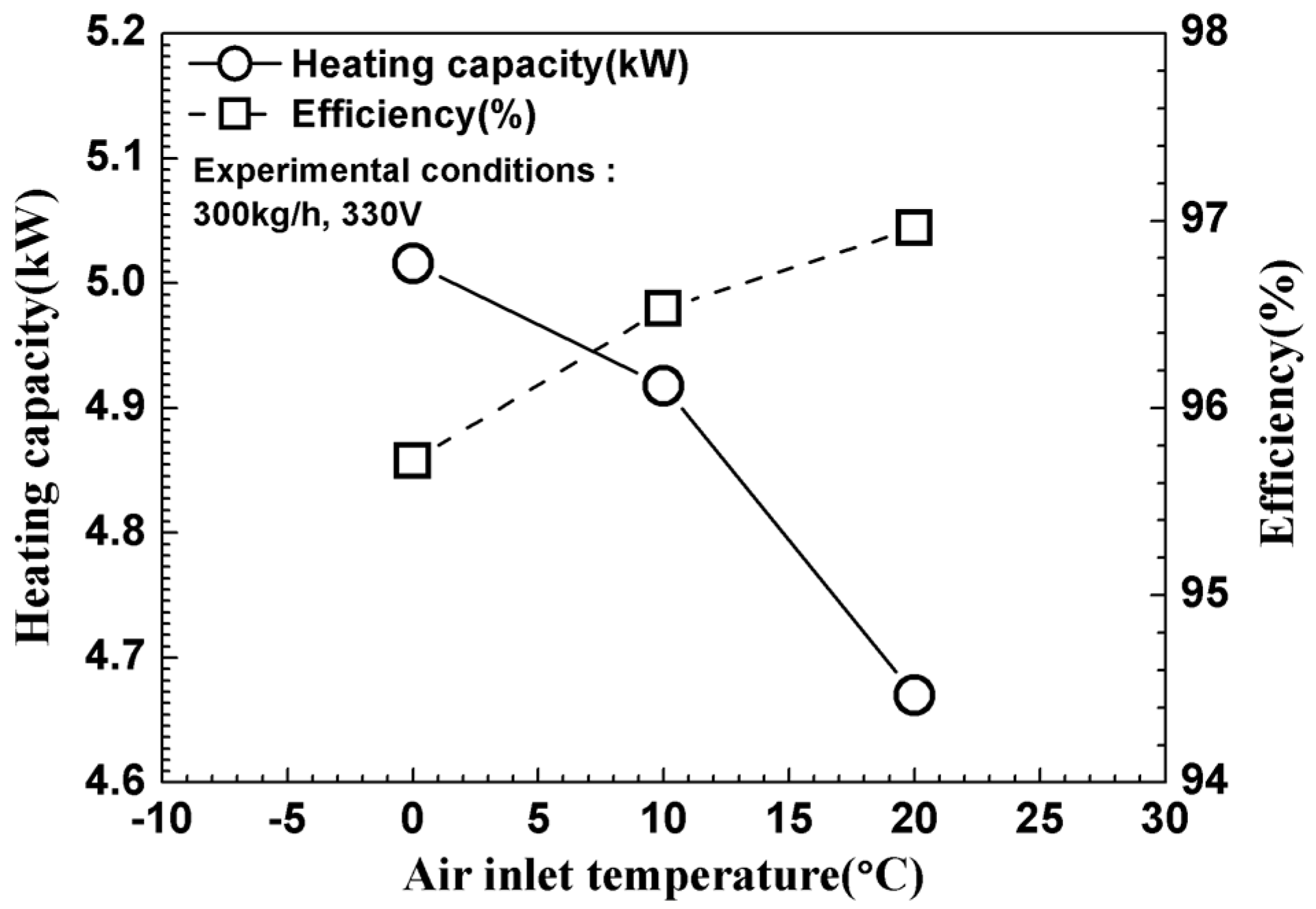
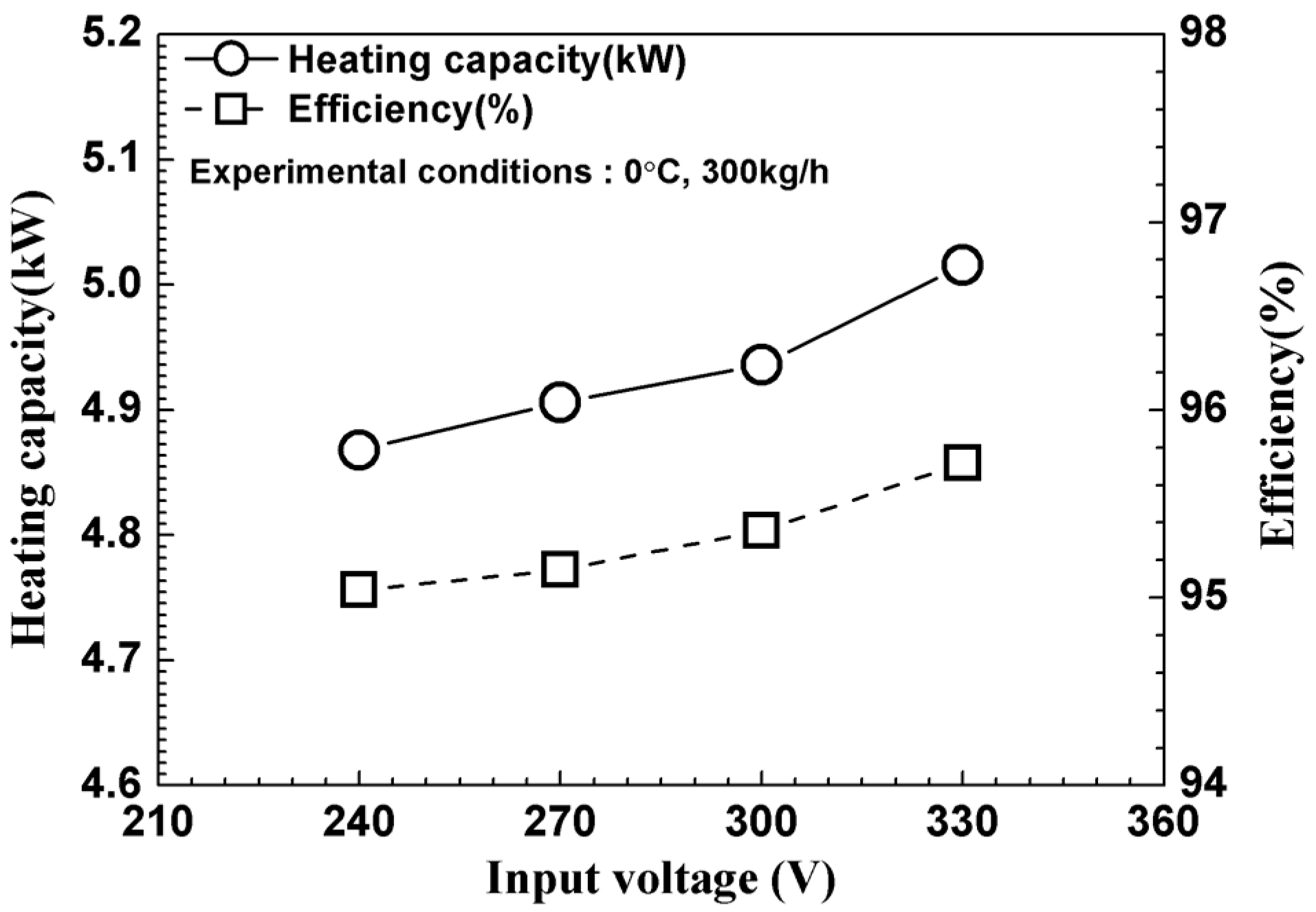
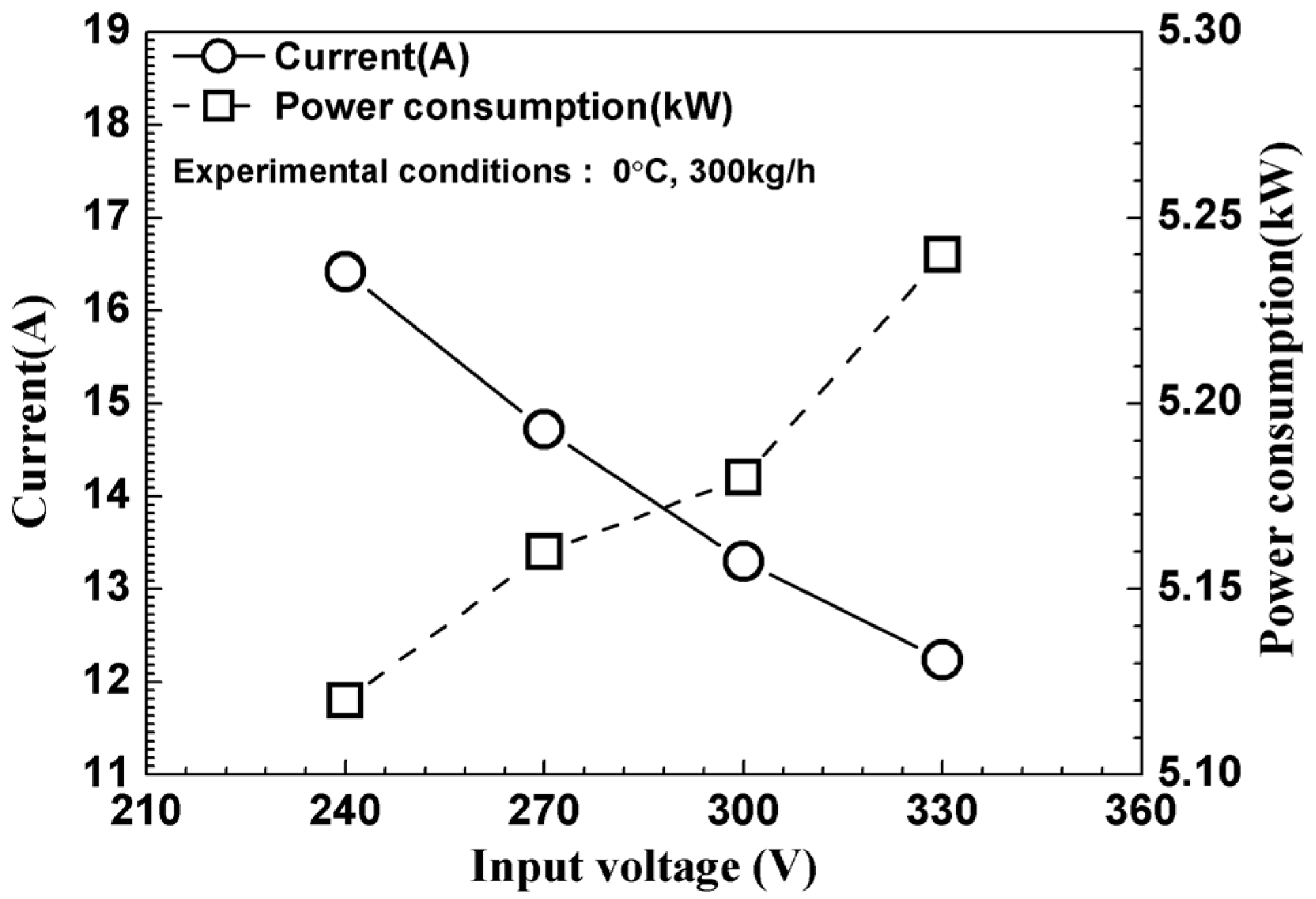
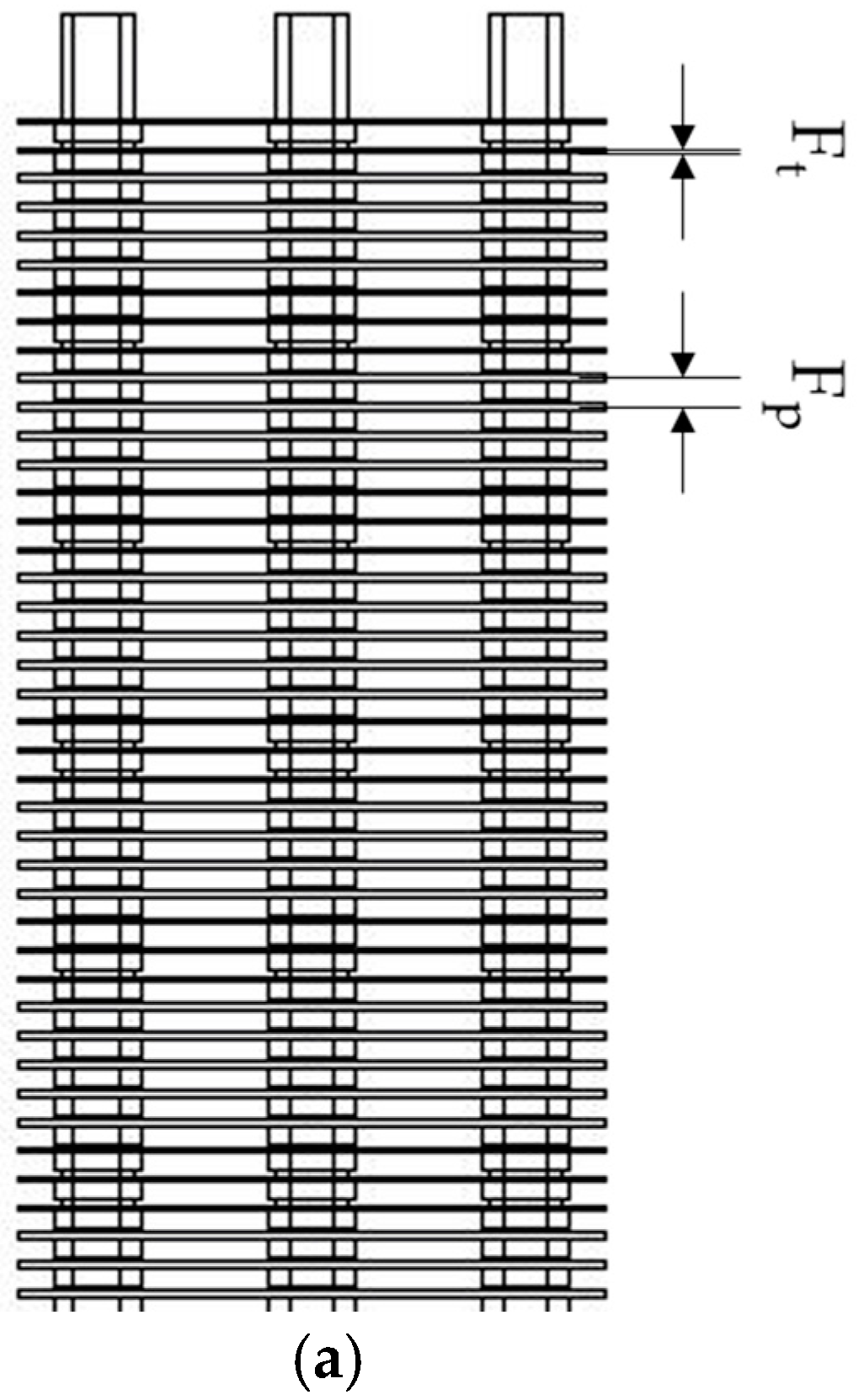
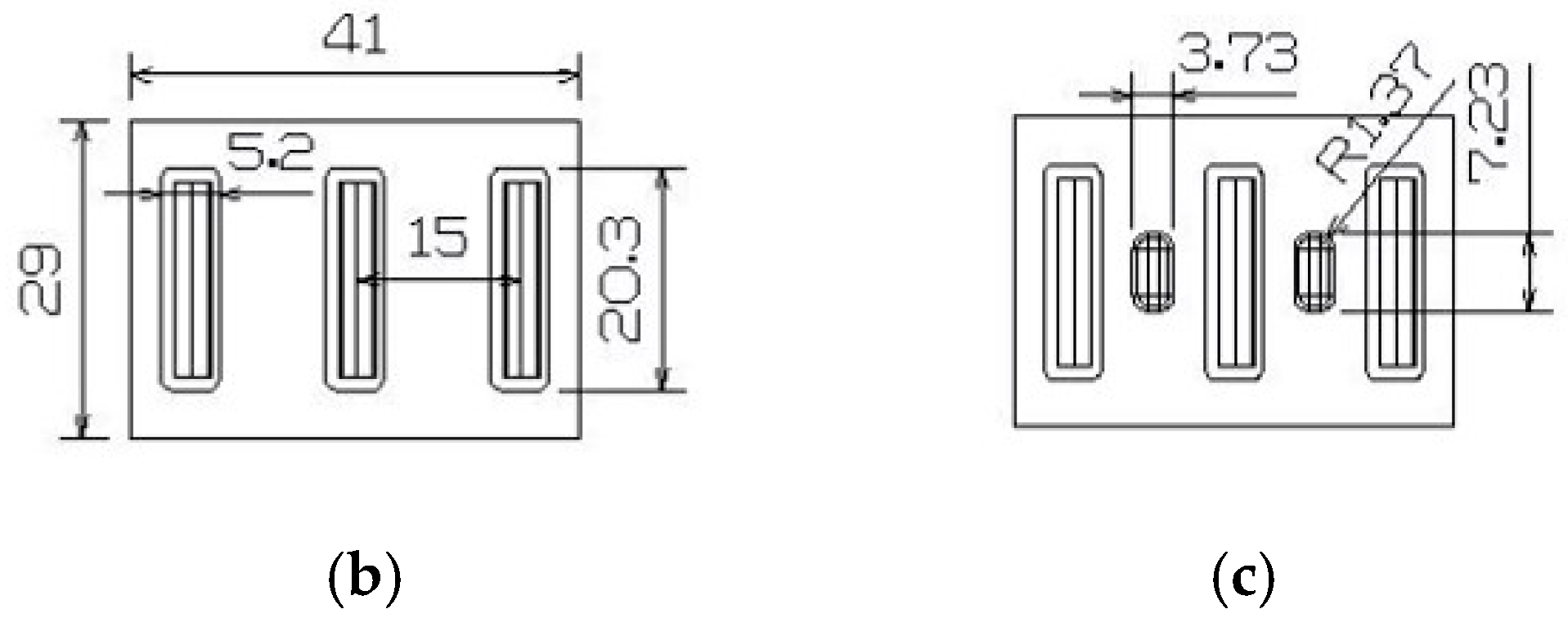
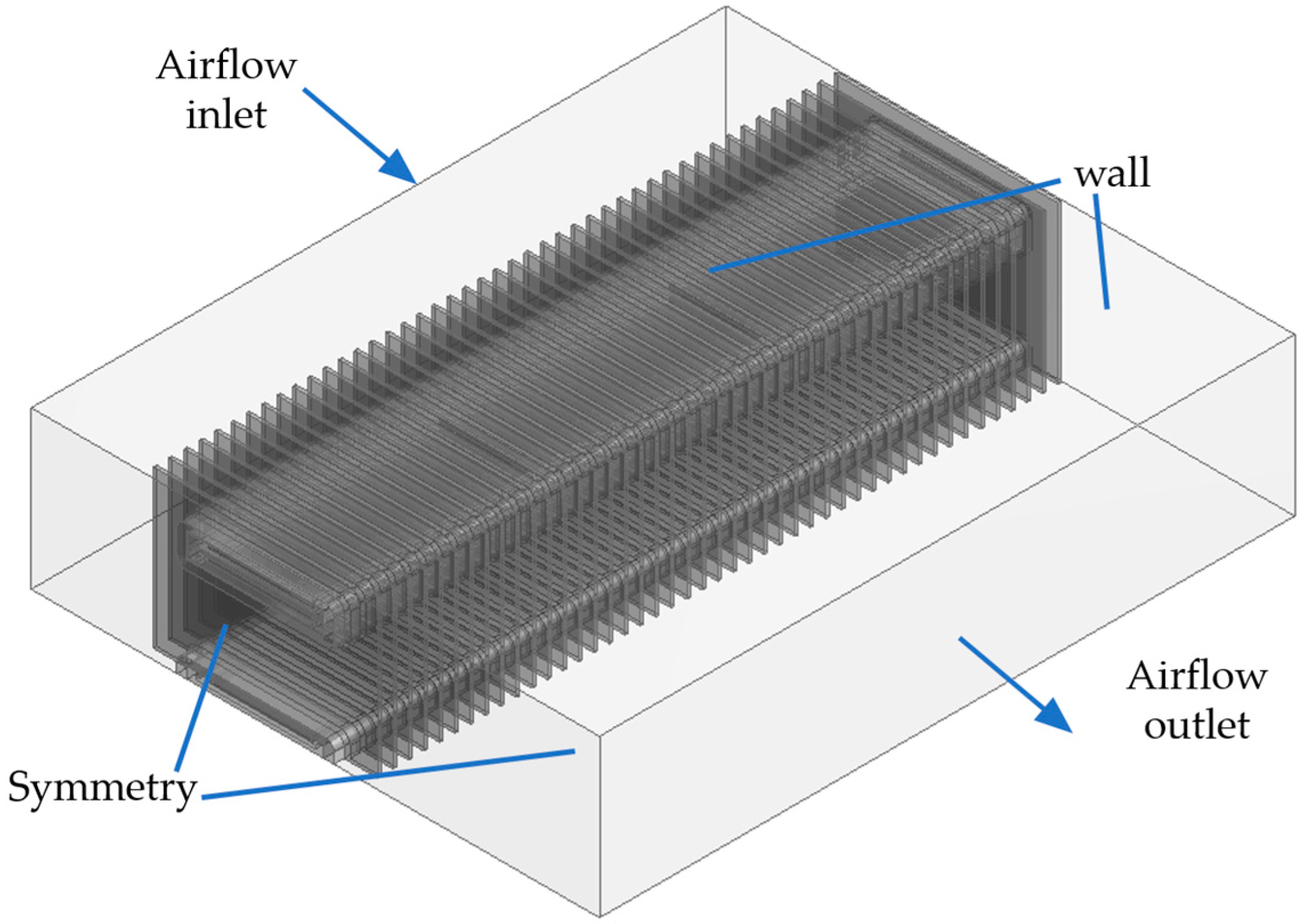
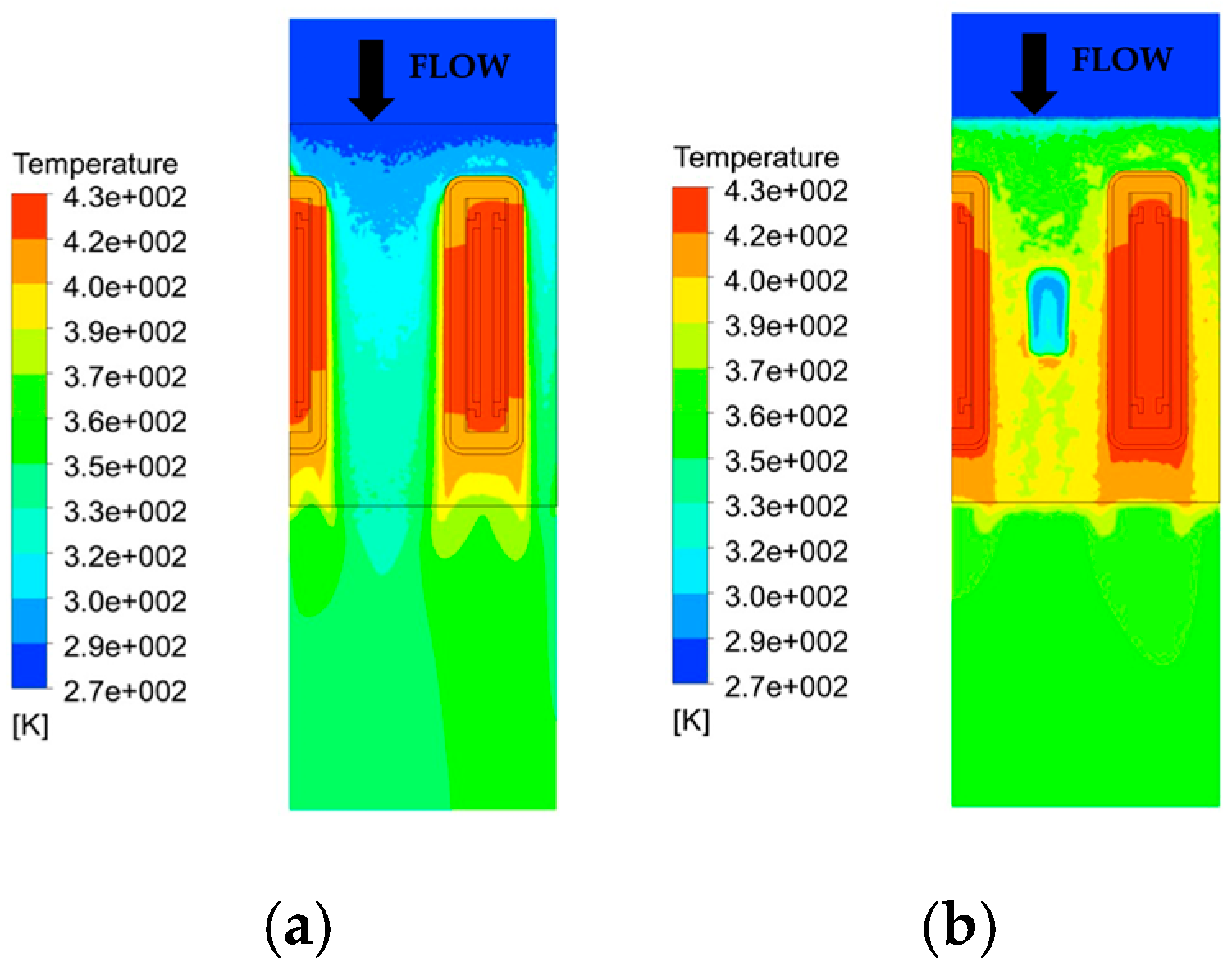
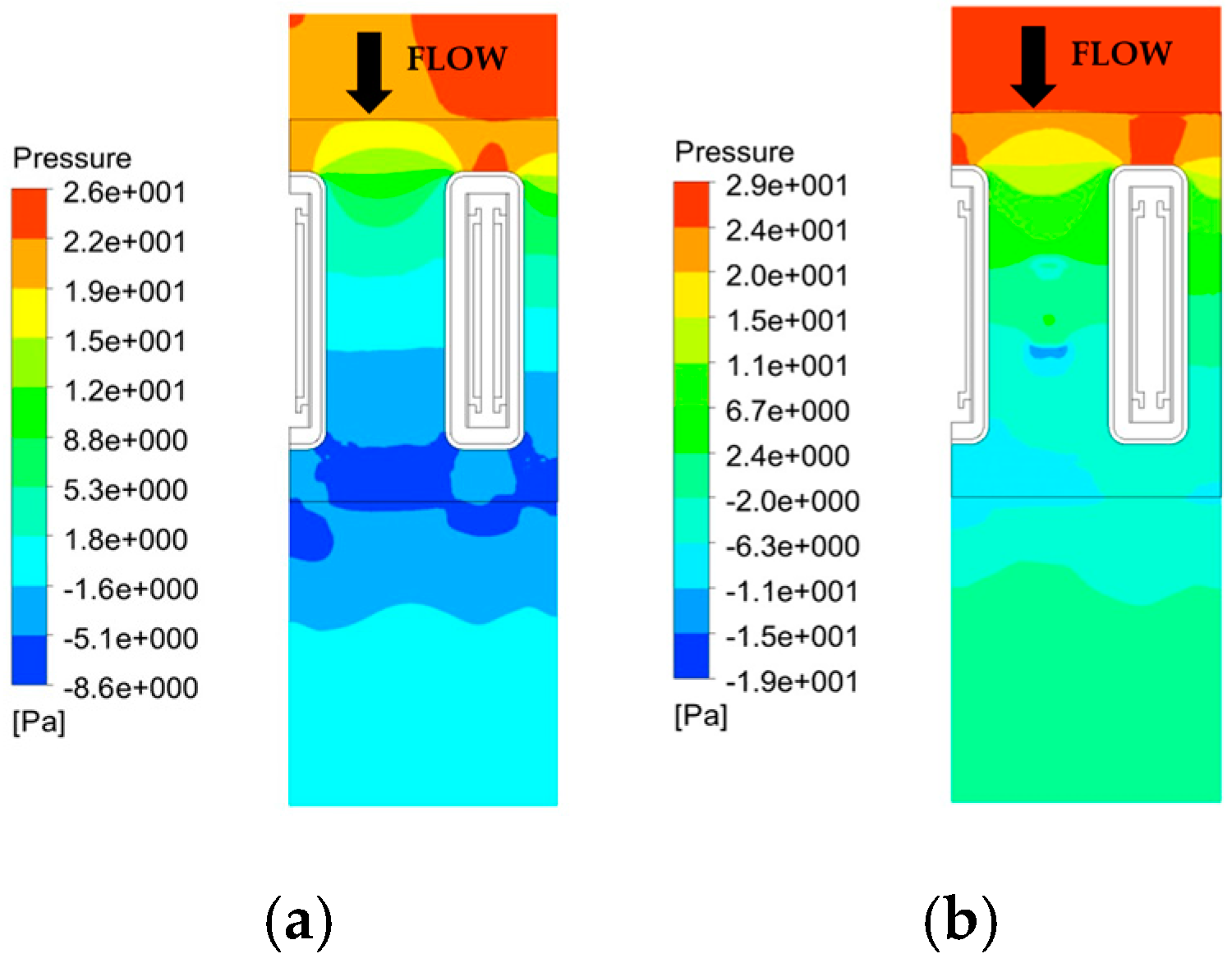
| Parameter | Heater A (Base Model) | Heater B (Enhanced Model) |
|---|---|---|
| Heater total size (mm3) | 200 (W) × 210 (H) × 28 (D) | |
| Heater module size (mm3) | 182 (W) × 186 (H) × 28 (D) | |
| Weight (kg) | 1.8 | 1.6 |
| Input voltage (V) | 330 | |
| Fin type | Plate | Emboss |
| Fin pitch (mm) | 2.0 | 1.6 |
| Fin thickness (mm) | 0.4 | 0.3 |
| Heat transfer area (mm3) | 501.1 | 507.6 |
| Component | Specification |
|---|---|
| Thermocouple (K-type) | ±0.1% (−60–200 °C), inlet 6 points, outlet 54 points |
| Diff. pressure gauge (Setra) | ±0.14% (0–0.5″ W.C.) |
| Pressure gauge (Setra) | ±0.25% (600–1100 mbar/hPa) |
| Pitot tube (Samdukeng) | Φ3.2 × 150 mm |
| Thermo-hygrometer (Kimo) | ±0.25% (0–50 °C), 5–95% RH, ±1.5% RH (where 15 °C ≤ T ≤ 25 °C) |
| Data acquisition system (NI) | 60 channels, 9–30 V @ 15 W |
| Blower (Dongkun) | Turbo fan, max volume flow rate: 5 m3/min |
| Experimental Conditions | Parameter |
|---|---|
| Mass flow rate (kg/h) | 100, 200, 300 *, 400, 500 |
| Temperature (°C) | 0 *, 10, 20 |
| Voltage (V) | 240, 270, 300, 330 * |
| Case | Case 1 | Case 2 | Case 3 | Case 4 |
|---|---|---|---|---|
| Fin type | Plate | Plate | Plate | Emboss |
| Fin pitch (mm) | 2.0 | 1.6 | 2.0 | 2.0 |
| Fin thickness (mm) | 0.4 | 0.4 | 0.3 | 0.4 |
| Part | Density (kg/m3) | Specific Heat (J/kg·°C) | Thermal Conductivity (W/m·°C) |
|---|---|---|---|
| PTC thermistor | 3890 | 779 | 36 |
| Guide | 1200 | 1050 | 0.23 |
| Terminal | 8470 | 380 | 116 |
| Insulator | 1600 | 840 | 2 |
| Heat bar | 2700 | 900 | 218 |
| Fin | 2680 | 880 | 138 |
| Description | Case 1 | Case 2 | Case 3 | Case 4 |
|---|---|---|---|---|
| Temperature difference (°C) | 76.1 | 81.5 | 72.2 | 79.8 |
| Heating capacity (kW) | 6.37 | 6.83 | 6.05 | 6.68 |
| Pressure drop (Pa) | 35.2 | 39.0 | 29.8 | 48.7 |
| Parameter | Heater A (Base Model) | Heater B (Enhanced Model) |
|---|---|---|
| Input current (A) | 15.9 | 17.1 |
| Power consumption (kW) | 5.24 | 5.63 |
| Temperature difference (°C) | 60.1 | 66.2 |
| Heating capacity (kW) | 5.02 | 5.52 |
| Pressure drop (Pa) | 40.4 | 48.2 |
| Energy efficiency (%) | 95.7 | 98.0 |
| Gravimetric power density (kW/kg) | 2.79 | 3.45 |
© 2017 by the authors. Licensee MDPI, Basel, Switzerland. This article is an open access article distributed under the terms and conditions of the Creative Commons Attribution (CC BY) license (http://creativecommons.org/licenses/by/4.0/).
Share and Cite
Park, M.H.; Kim, S.C. Heating Performance Characteristics of High-Voltage PTC Heater for an Electric Vehicle. Energies 2017, 10, 1494. https://doi.org/10.3390/en10101494
Park MH, Kim SC. Heating Performance Characteristics of High-Voltage PTC Heater for an Electric Vehicle. Energies. 2017; 10(10):1494. https://doi.org/10.3390/en10101494
Chicago/Turabian StylePark, Myeong Hyeon, and Sung Chul Kim. 2017. "Heating Performance Characteristics of High-Voltage PTC Heater for an Electric Vehicle" Energies 10, no. 10: 1494. https://doi.org/10.3390/en10101494
APA StylePark, M. H., & Kim, S. C. (2017). Heating Performance Characteristics of High-Voltage PTC Heater for an Electric Vehicle. Energies, 10(10), 1494. https://doi.org/10.3390/en10101494





